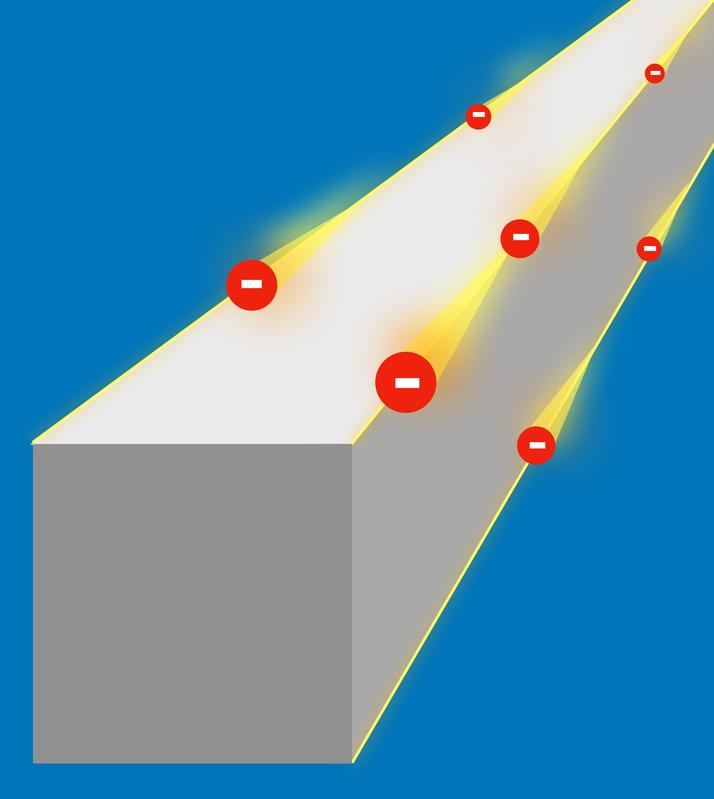Novel Insulators with Conducting Edges

Schematic of a higher-order topological insulator in the shape of a nanowire, with conducting channels on its edges UZH
Topology examines the properties of objects and solids that are protected against perturbations and deformations. Materials known so far include topological insulators, which are crystals that insulate on the inside but conduct electrical current on their surface. The conducting surfaces are topologically protected, which means that they cannot easily be brought into an insulating state.
New class of materials: Higher-order topological insulators
Theoretical physicists at the University of Zurich have now predicted a new class of topological insulators that have conducting properties on the edges of crystals rather than on their surface. The research team, made up of scientists from UZH, Princeton University, the Donostia International Physics Center and the Max Planck Institute of Microstructure Physics in Halle, dubbed the new material class “higher-order topological insulators”. The extraordinary robustness of the conducting edges makes them particularly interesting: The current of topological electrons cannot be stopped by disorder or impurities. If an imperfection gets in the way of the current, it simply flows around the impurity.
Like a highway for electrons
In addition, the crystal edges do not have to be specially prepared to conduct electrical current. If the crystal breaks, the new edges automatically also conduct current. “The most exciting aspect is that electricity can at least in theory be conducted without any dissipation,” says Titus Neupert, professor at the Department of Physics at UZH.
“You could think of the crystal edges as a kind of highway for electrons. They can't simply make a U-turn.” This property of dissipationless conductance, otherwise known from superconductors at low temperatures, is not shared with the previously known topological insulator crystals that have conducting surfaces, but is specific to the higher-order topological crystals.
Further theoretical and experimental research needed
The physicists' study still mostly relies on theoretical aspects. They have proposed tin telluride as the first compound to show these novel properties. “More material candidates have to be identified and probed in experiments,” says Neupert. The researchers hope that in the future nanowires made of higher-order topological insulators may be used as conducting paths in electric circuits. They could be combined with magnetic and superconducting materials and used for building quantum computers.
Literature:
Frank Schindler, Ashley M. Cook, Maia G. Vergniory, Zhijun Wang, Stuart S. P. Parkin, B. Andrei Bernevig, Titus Neupert. Higher-order topological insulators. Science Advances, June 1st, 2018. DOI: 10.1126/sciadv.aat0346
Contacts:
Prof. Dr. Titus Neupert
Department of Physics
University of Zurich
Phone +41 44 635 48 00
E-mail: titus.neupert@uzh.ch
Media Contact
All latest news from the category: Physics and Astronomy
This area deals with the fundamental laws and building blocks of nature and how they interact, the properties and the behavior of matter, and research into space and time and their structures.
innovations-report provides in-depth reports and articles on subjects such as astrophysics, laser technologies, nuclear, quantum, particle and solid-state physics, nanotechnologies, planetary research and findings (Mars, Venus) and developments related to the Hubble Telescope.
Newest articles

Silicon Carbide Innovation Alliance to drive industrial-scale semiconductor work
Known for its ability to withstand extreme environments and high voltages, silicon carbide (SiC) is a semiconducting material made up of silicon and carbon atoms arranged into crystals that is…

New SPECT/CT technique shows impressive biomarker identification
…offers increased access for prostate cancer patients. A novel SPECT/CT acquisition method can accurately detect radiopharmaceutical biodistribution in a convenient manner for prostate cancer patients, opening the door for more…

How 3D printers can give robots a soft touch
Soft skin coverings and touch sensors have emerged as a promising feature for robots that are both safer and more intuitive for human interaction, but they are expensive and difficult…





















